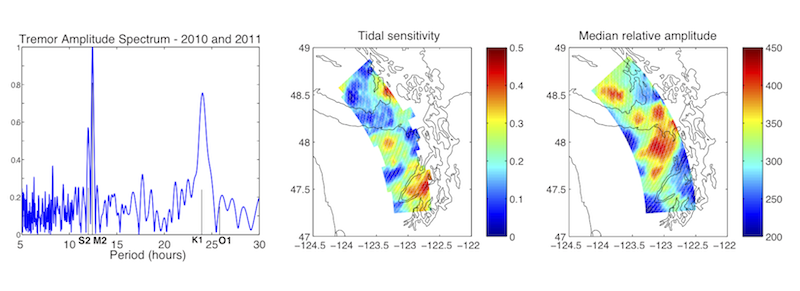2012 IRIS Workshop
Influence of Tides on Cascadia Tremor Amplitudes
Amanda Klaus: University of Washington, Ken Creager: University of Washington, Aaron Wech: Victoria University of Wellington, Justin Sweet: University of Washington
(a) Tremor amplitude spectrum for 2010 and 2011 episodic tremor and slip (ETS) events, showing a large peak coincident with the 12.4-hour M2 tide and secondary peaks at the S2 and K1 tides. (b) Sensitivity of tremor amplitude to the 12.4-hr tide using the method of Ide (2010). (c) Median amplitude of tremors within a 10-km radius. There is a clear anticorrelation between high amplitudes and high tidal sensitivity, consistent with Ide if our high amplitudes correspond to his long durations.

Full-resolution graphics file in original format: 0113.ai
We recorded the 2010 and 2011 episodic tremor and slip (ETS) events, as well as several small inter-ETS events in 2010, on the EarthScope-funded CAFE and Array of Arrays experiments on the Olympic Peninsula. This includes nine arrays of 6 to 20 stations each as well as five quiet single stations. We deconvolve the instrument response, filter from 1.5 to 5.5 Hz, and make envelopes. Horizontal component envelopes are then stacked across arrays to improve signal-to-noise. Tremor locations come from Aaron Wech's tremor catalog (Wech and Creager, 2008). Using these amplitudes and locations, an inversion compensates for site corrections, geometric spreading, and attenuation to produce a single relative amplitude measurement at the source every five minutes. A tidal modulation of the data is apparent in the tremor amplitude spectrum, whose largest peak occurs at 12.4 hours, consistent with the M2 tidal period. There are also significant peaks at 12 and 24 hours. The 23.9 hour K1 tidal period, however, is difficult to separate out from the 24 hour cultural noise cycle. Modifying the method of Ide (2010), we calculate tidal sensitivity scaled by tremor amplitude. The tidal sensitivity calculation takes 100 tremors within a 10 km radius of a grid point and calculates how similar the time distribution of tremor is to the tidal period. Sensitivity would equal 1 if tremors happened every 12.4 hours and zero if randomly distributed. The plot of tidal sensitivity reveals a marked spatial anticorrelation with tremor amplitude, suggesting that both are related to rheological heterogeneity of the plate interface. Comparing the tremor amplitudes directly with the tidal stress model of Hawthorne and Rubin (2010) is complex, but it appears that shear stress is much more important than normal stress in modulating tremor amplitude.
Acknoweldgements: We used data from the EarthScope-funded CAFE and Array of Arrays experiments.
Keywords: tremor, episodic_tremor_and_slip, tides, tidal_stress, slow_slip, cascadia, tremor_amplitude
